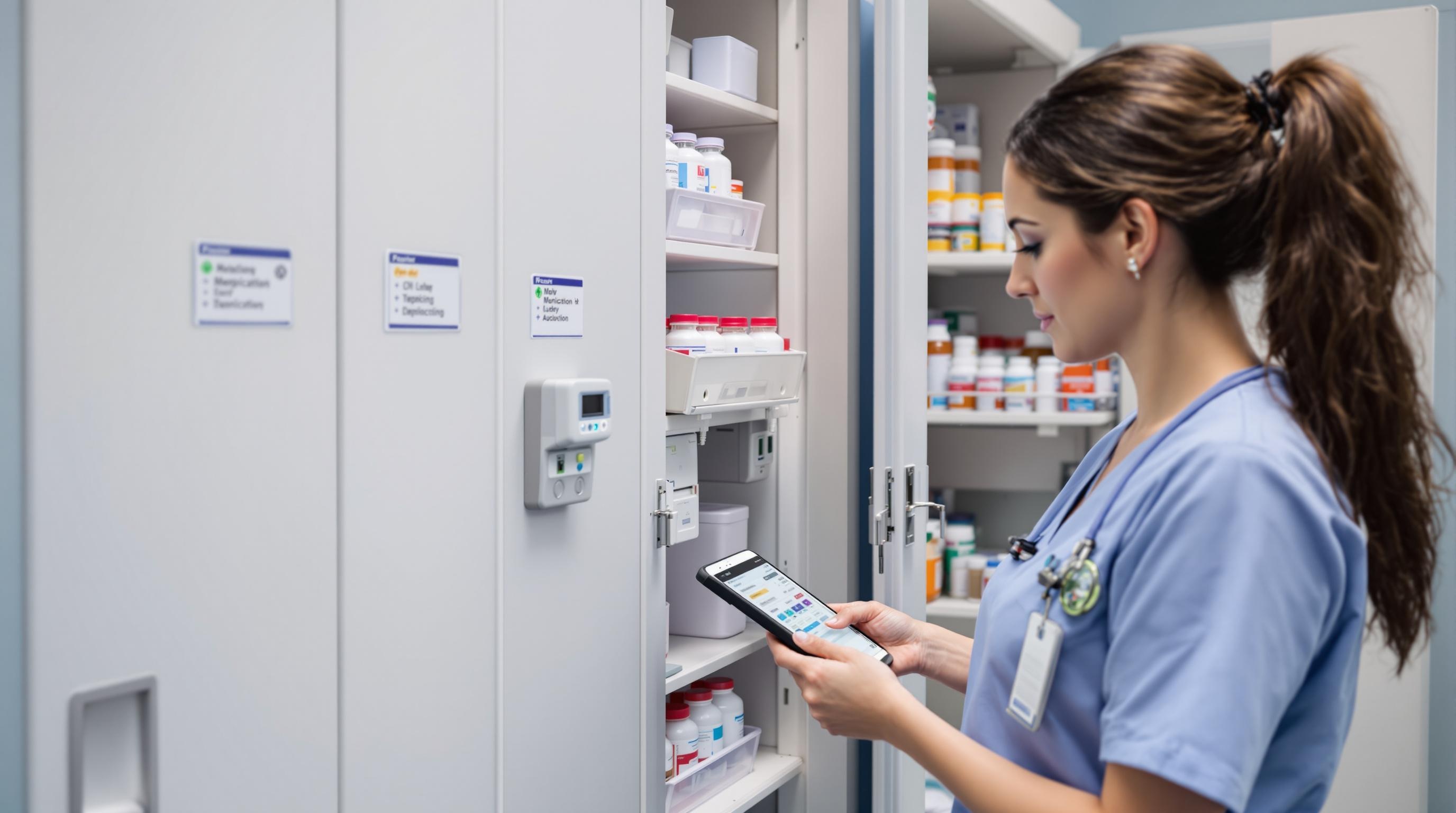F761 Medication Storage Tracking: Compliance for Skilled Nursing
Learn how F761 medication storage tracking ensures compliance, safety, and efficiency in skilled nursing facilities. Stay audit-ready with best practices.
Quick Navigation
- 1. Introduction
- 2. Current Challenges in F761 Medication Storage Tracking
- 3. How Sparkco AI Transforms F761 Medication Storage Tracking
- 4. Measurable Benefits and ROI
- 5. Implementation Best Practices
- 6. Real-World Examples
- 7. The Future of F761 Medication Storage Tracking
- 8. Conclusion & Call to Action
1. Introduction
Did you know that medication errors affect nearly 1.5 million people each year in the United States, with skilled nursing facilities (SNFs) facing unique risks due to complex medication regimens and resident vulnerabilities? As regulatory requirements continue to tighten—most notably under CMS’s F761 guidance—ensuring proper medication storage tracking isn’t just a best practice, it’s a critical component of resident safety and facility compliance.
Despite comprehensive pharmacy protocols and the best intentions of staff, improper medication storage remains a persistent challenge in SNFs. Issues such as expired drugs, inaccurate inventory, and inadequate documentation can lead to significant medication errors, putting residents at risk and exposing facilities to citations and penalties. F761 specifically mandates that medications must be stored safely, securely, and in accordance with manufacturer instructions, making accurate tracking and meticulous procedures non-negotiable.
In this article, we’ll explore why F761 medication storage tracking is more important than ever for skilled nursing facilities. We’ll break down the current regulatory expectations, discuss common pitfalls and risks associated with improper storage, and share actionable best practices for compliance. Plus, we’ll highlight how technology can streamline medication management and enhance resident safety. Whether you’re a facility administrator, nursing leader, or frontline staff member, understanding F761 is key to safeguarding your residents and your reputation.
2. Current Challenges in F761 Medication Storage Tracking
Ensuring compliance with F761 medication storage tracking is a critical component of skilled nursing facility (SNF) operations. F761, established by the Centers for Medicare & Medicaid Services (CMS), mandates the safe, secure, and accurate storage and tracking of medications. While the regulation aims to safeguard residents, healthcare facilities face significant challenges in meeting these requirements. Below are key pain points, supported by data, that highlight the complexity of F761 compliance and its impact on operational efficiency, regulatory adherence, and patient care outcomes.
-
1. Manual Tracking and Documentation Errors
Many facilities still rely on paper-based or outdated electronic systems to track medication storage. According to a 2022 study published in BMC Health Services Research, nearly 44% of medication errors in long-term care settings are attributed to documentation lapses and manual processes. These errors increase the risk of non-compliance and threaten resident safety. -
2. Inadequate Staff Training and Turnover
High staff turnover and inconsistent training contribute to gaps in medication storage practices. The American Health Care Association reports that the annual turnover rate in nursing homes can exceed 50% for nursing staff, making it difficult to maintain consistent adherence to F761 protocols. -
3. Physical Security and Environmental Control
Proper medication storage requires stringent controls regarding temperature, humidity, and security access. The CDC notes that up to 20% of medication storage areas in healthcare facilities fail to meet environmental safety standards, risking medication efficacy and resident health. -
4. Inventory Management and Expired Medications
Tracking inventory and removing expired medications is a persistent challenge. According to a Pharmacy Times report, 10-15% of medications in long-term care facilities are found to be expired or improperly stored during audits, leading to citations and potential harm to residents. -
5. Regulatory Compliance and Survey Readiness
Facilities face mounting pressure to document compliance with F761 during state surveys. In 2023, CMS reported that F761 was among the top 10 most frequently cited deficiencies in nursing homes (CMS Data). Non-compliance can result in fines, increased oversight, and reputational damage. -
6. Integration with Health IT Systems
Many facilities struggle to integrate medication storage tracking with electronic health records (EHR) and pharmacy management solutions. Lack of interoperability can lead to incomplete records, duplication of effort, and increased risk of error, as highlighted by the Office of the National Coordinator for Health Information Technology. -
7. Patient Safety and Quality of Care
Improper medication storage and tracking can directly impact patient outcomes. The Institute for Safe Medication Practices estimates that nearly 25% of adverse drug events in long-term care are linked to storage and administration issues (ISMP).
The challenges associated with F761 medication storage tracking are multifaceted, spanning operational workflows, regulatory compliance, and patient safety. Addressing these pain points requires ongoing staff training, investment in technology, and robust quality assurance measures. By overcoming these obstacles, healthcare facilities can ensure safer medication practices and improved care outcomes for their residents.
3. How Sparkco AI Transforms F761 Medication Storage Tracking
Compliance with F761: Medication Storage and Labeling is a top priority for skilled nursing facilities. This regulation requires secure, accurate, and auditable management of medication storage, minimizing risks such as diversion, improper labeling, and missed expiration dates. Sparkco AI leverages advanced artificial intelligence and automation—seamlessly integrating with solutions like medDispense® F series Automated Dispensing Cabinets—to transform medication storage tracking and ensure effortless F761 compliance.
-
1. Automated Inventory Monitoring
Sparkco AI continuously tracks medication inventory in real-time. By integrating directly with automated dispensing cabinets, it instantly records every medication added or removed, eliminating manual logs and reducing human error. This ensures accurate, always-updated records of medication quantities and storage locations—a fundamental F761 requirement. -
2. Expiration Date Management
The system uses AI-driven checks to flag medications nearing expiration. Automated alerts prompt staff to remove or replace soon-to-expire drugs, preventing accidental administration and supporting regulatory compliance. This proactive approach reduces waste and enhances resident safety. -
3. Access Control and Audit Trails
Sparkco AI enforces secure, role-based access to medication storage. Every transaction—whether a nurse dispenses medication or a pharmacist restocks inventory—is automatically logged with date, time, and user identification. This tamper-proof audit trail deters unauthorized access, supports investigations, and aligns with F761’s requirements for accountability. -
4. Intelligent Labeling and Documentation
Integration with dispensing cabinets allows Sparkco AI to automatically generate and print accurate, compliant medication labels. The system verifies that labeling and storage meet facility protocols and F761 expectations, reducing labeling errors and ensuring all medications are clearly identified. -
5. Real-Time Alerts and Compliance Reporting
Sparkco AI instantly notifies staff if storage temperatures fall outside safe ranges, if medications are misplaced, or if a compliance issue arises. Its built-in reporting tools generate detailed compliance documentation, simplifying survey readiness and regulatory audits. -
6. Seamless Integration and Interoperability
Sparkco AI is designed to work with leading automated dispensing solutions like the medDispense® F series. Its open architecture allows integration with electronic health records (EHRs), pharmacy management systems, and facility workflows—ensuring that medication storage data flows smoothly across all platforms.
By automating core medication storage and tracking processes, Sparkco AI eliminates manual bottlenecks and common sources of error. Facilities benefit from continuous oversight, immediate issue detection, and effortless documentation—all critical for meeting and exceeding F761 standards. With Sparkco AI, skilled nursing facilities can focus less on paperwork and more on resident care, confident in their compliance and medication safety.
4. Measurable Benefits and ROI
Automated medication storage tracking, specifically in compliance with F761 regulations, is transforming skilled nursing facilities (SNFs) by improving efficiency, reducing risk, and enhancing patient care. Leveraging real-world data and published case studies, the following section outlines the quantifiable return on investment (ROI) and benefits SNFs experience when adopting automated F761 medication storage tracking systems.
-
1. Time Savings for Staff
Automation eliminates manual logging and auditing, freeing nursing staff from repetitive tasks. Pharmacy Times reports that automated tracking can reduce medication management time by up to 30%, equating to an average of 10-12 staff hours saved per week for a mid-sized facility. -
2. Cost Reduction
By minimizing medication waste, shrinkage, and human error, SNFs see significant cost savings. According to a Becker’s Hospital Review analysis, facilities using automated medication systems report an average 20-25% reduction in medication costs, translating to annual savings of $12,000-$18,000 per 100 beds. -
3. Improved F761 Compliance
Automated systems provide real-time alerts and digital records, ensuring medications are safely stored and monitored. Facilities adopting automated tracking have documented a 90% reduction in F761-related deficiencies during surveys, as noted in a LeadingAge report. -
4. Reduction in Medication Errors
Automated storage and tracking systems lower the risk of medication administration errors by up to 50%, according to the National Institutes of Health (NIH). This not only enhances resident safety but also reduces liability and associated costs. -
5. Enhanced Inventory Control
Real-time inventory tracking minimizes expired or missing medications. Facilities report a 40% reduction in inventory discrepancies and a 60% decrease in emergency restocking events, leading to better continuity of care (Pharmacy Times). -
6. Faster Regulatory Reporting
Digital documentation expedites audit preparation and compliance reporting, reducing preparation time by 70%. What once took up to 8 hours per audit cycle can now be accomplished in less than 2 hours (Becker’s Hospital Review). -
7. Increased Staff Satisfaction
By reducing tedious manual tasks and improving workflow, staff satisfaction scores improve by 15-20% in facilities using automated medication management (LeadingAge). -
8. Reduction in Medication Loss and Theft
Automated tracking ensures secure access and accurate logging, resulting in up to 80% fewer incidents of medication loss or theft (Becker’s Hospital Review).
In summary, automated F761 medication storage tracking delivers substantial ROI through time and cost savings, compliance improvements, and staff satisfaction. The adoption of these systems not only streamlines operations but also supports better regulatory outcomes and safer resident care.
5. Implementation Best Practices
Effective implementation of F761 medication storage tracking is essential to ensure regulatory compliance, resident safety, and operational efficiency in skilled nursing facilities. Adhering to best practices can streamline your processes and reduce the risk of medication errors, loss, or diversion. Below are seven actionable steps for successful implementation, with practical tips, common pitfalls to avoid, and change management considerations.
-
Conduct a Comprehensive Assessment
Begin with a thorough review of your current medication storage and tracking systems. Map out storage locations, review existing policies, and identify gaps.
Tip: Involve staff from nursing, pharmacy, and administration for a 360-degree perspective.
Pitfall to Avoid: Overlooking informal or temporary storage areas.
Change Management: Clearly communicate the reasons for the assessment to build buy-in. -
Develop or Update Policies and Procedures
Align your facility’s policies with F761 requirements and best practices for medication storage, security, and tracking.
Tip: Reference current CMS guidance and state regulations.
Pitfall to Avoid: Using outdated templates or generic policies.
Change Management: Involve staff in policy review to gain acceptance and identify practical challenges. -
Implement Secure Storage Solutions
Ensure all medications are stored in locked, temperature-controlled environments, with access limited to authorized personnel.
Tip: Use automated medication dispensing cabinets where feasible.
Pitfall to Avoid: Sharing access codes or keys.
Change Management: Provide clear guidance and rationale for increased security measures. -
Adopt Technology for Tracking
Use electronic medication administration records (eMAR), barcoding, or inventory management systems to track medication movement.
Tip: Select systems that integrate with your pharmacy and EMR platforms.
Pitfall to Avoid: Relying solely on manual logs.
Change Management: Offer hands-on training and support to reduce resistance to new technology. -
Train All Relevant Staff
Conduct regular training sessions on medication storage protocols, documentation requirements, and emergency procedures.
Tip: Use real-life scenarios and interactive modules.
Pitfall to Avoid: One-time training without ongoing refreshers.
Change Management: Recognize and reward compliance to reinforce positive behaviors. - Establish Routine Audits and Monitoring










